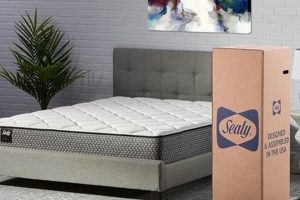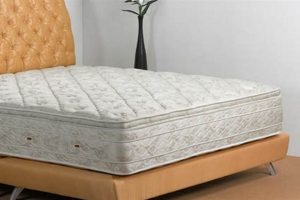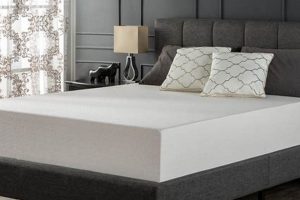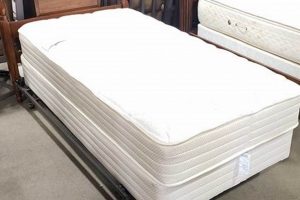A supportive foundation designed to complement the characteristics of a hybrid mattress a bed combining both innerspring coils and foam layers is crucial for optimal performance. The right support structure provides stability, prevents sagging, and enhances the overall comfort and longevity of the mattress itself. For instance, a platform base with evenly spaced slats can offer firm, consistent support across the entire mattress surface.
Employing a suitable foundation offers several advantages. It protects the mattress investment by distributing weight evenly and minimizing wear and tear. Furthermore, it promotes proper spinal alignment by preventing the mattress from sinking or conforming unevenly. Historically, box springs were primarily coil-based, but modern designs often incorporate solid or slatted platforms to better support the denser constructions of hybrid mattresses. Selecting the correct foundation extends the lifespan of the mattress and contributes to improved sleep quality.
The subsequent discussion will delve into the key features to consider when choosing an appropriate support system, explore different types of foundations available, and provide guidance on matching the ideal support structure to specific hybrid mattress characteristics.
Guidance for Foundation Selection
The following recommendations are provided to assist in the selection of a suitable support structure.
Tip 1: Assess Mattress Weight and Density: Hybrid mattresses tend to be heavier than traditional innerspring models due to the multiple layers of foam. Ensure the chosen foundation possesses a weight-bearing capacity exceeding that of the mattress.
Tip 2: Evaluate Slat Spacing: For slatted platforms, smaller gaps between slats generally provide greater support. Gaps exceeding a few inches may lead to uneven weight distribution and premature mattress wear.
Tip 3: Consider Foundation Height: Foundation height influences the overall bed height. Factor in personal preference and ease of access when selecting a foundation with a specific height profile.
Tip 4: Verify Frame Compatibility: Confirm that the chosen foundation is compatible with the existing bed frame, if applicable. Standard sizes, such as Queen or King, should align appropriately.
Tip 5: Examine Edge Support: A foundation with reinforced edges provides enhanced stability and prevents the mattress from sagging along its perimeter. This feature is particularly beneficial for individuals who sleep near the edge of the bed.
Tip 6: Review Warranty Information: Carefully review the manufacturer’s warranty for both the mattress and the foundation. Utilizing an incompatible foundation may void the mattress warranty.
Tip 7: Seek Professional Advice: Consult with a mattress specialist or sales representative to obtain personalized recommendations based on the specific hybrid mattress model.
Adhering to these guidelines can help ensure that the selected foundation provides optimal support, prolongs mattress lifespan, and contributes to improved sleep comfort.
The subsequent sections will address specific types of foundations and provide detailed comparisons to facilitate informed decision-making.
1. Firmness
Foundation firmness directly impacts the perceived comfort and support of a hybrid mattress. A foundation lacking adequate firmness may allow excessive sinking, compromising spinal alignment and negating the supportive properties of the mattress itself. Conversely, an overly firm foundation can restrict the mattress’s ability to conform to the body, reducing pressure relief and overall comfort. The ideal firmness level complements the mattress’s construction, providing a stable base that enhances, rather than detracts from, its design features.
Consider a hybrid mattress designed with a medium-firm feel. Pairing it with a soft, yielding foundation could result in a “bottoming out” sensation, where the sleeper’s weight compresses the mattress excessively, diminishing its ability to provide proper support. Conversely, placing the same mattress on a rock-solid foundation might make it feel uncomfortably rigid. Therefore, selecting a foundation with a comparable firmness profile to the mattress is crucial for achieving a balanced and comfortable sleep surface. The firmness level should facilitate the proper engagement of the mattress’s layers, allowing it to provide targeted support and pressure relief.
Ultimately, the connection between foundation firmness and hybrid mattress performance is fundamental to achieving optimal sleep. An unsuitable firmness level can compromise the mattress’s intended design characteristics, leading to discomfort, reduced support, and potentially, a shortened lifespan. Careful consideration of firmness, relative to the mattress’s characteristics, is essential for maximizing the investment and realizing the intended benefits of the hybrid design.
2. Support
The concept of support is central to evaluating the suitability of a foundation for a hybrid mattress. The foundation’s primary role is to provide consistent and reliable support, ensuring the mattress maintains its structural integrity and provides optimal comfort to the sleeper. Inadequate support can lead to premature mattress sagging, uneven weight distribution, and ultimately, a compromised sleep experience.
- Weight Distribution
An effective foundation evenly distributes the weight of the mattress and its occupants. This prevents concentrated pressure points that can lead to mattress deformation and discomfort. For instance, a platform foundation with closely spaced slats offers superior weight distribution compared to a traditional coil-based box spring with potentially uneven coil spacing. The even distribution extends the mattress’s lifespan and enhances the quality of sleep.
- Spinal Alignment
Appropriate support is essential for maintaining proper spinal alignment during sleep. A foundation that sags or allows the mattress to conform unevenly can disrupt the natural curvature of the spine, leading to back pain and discomfort. A solid or closely slatted foundation provides a stable and level surface, promoting proper spinal alignment and reducing the risk of musculoskeletal issues. Consider the scenario where an individual experiences lower back pain due to sleeping on an unsupportive surface; replacing it with a proper foundation often alleviates this issue.
- Edge Support Enhancement
A foundation with reinforced edges provides added stability along the perimeter of the mattress. This prevents edge sagging, which can be a common issue with hybrid mattresses, especially those with softer foam layers. Strong edge support increases the usable sleep surface and makes it easier to get in and out of bed. Examples include foundations with solid wood frames and reinforced corner construction.
- Prevention of Motion Transfer
While the mattress itself plays a significant role in motion isolation, the foundation also contributes. A stable and solid foundation minimizes the transmission of movement across the bed surface. This is particularly beneficial for couples, as it reduces the likelihood of one partner’s movements disturbing the other’s sleep. For instance, a platform foundation made of solid wood will generally provide better motion isolation compared to a traditional box spring with interconnected coils.
In conclusion, the level of support provided by a foundation is a critical factor in determining its compatibility with a hybrid mattress. From evenly distributing weight to maintaining spinal alignment and minimizing motion transfer, each facet of support contributes to the overall performance and longevity of the sleep system. The selection of a foundation that prioritizes these elements is essential for realizing the full benefits of a hybrid mattress and ensuring a restful and restorative sleep experience.
3. Durability
Durability constitutes a foundational element in evaluating the suitability of any support structure for a hybrid mattress. The longevity of a support system is directly correlated with its capacity to withstand the consistent weight and stress imposed by the mattress and its occupants. Inadequate durability leads to premature failure of the foundation, resulting in sagging, uneven support, and ultimately, a reduction in the lifespan and performance of the hybrid mattress itself. The selection of a support structure constructed from robust materials and employing sound engineering principles is, therefore, an essential consideration.
The materials used in the construction of the support system directly influence its durability. For instance, a platform foundation constructed from solid hardwoods, such as oak or maple, will typically exhibit greater resistance to warping and cracking compared to one fabricated from particleboard or low-density fiberboard. Similarly, a metal frame utilizing heavy-gauge steel provides enhanced structural integrity compared to a frame constructed from thinner, less resilient metals. The quality of joinery and fastening methods also contributes to the overall durability of the structure. Reinforced corners, securely fastened slats, and robust connecting hardware minimize the risk of component failure under sustained load. An example is a slatted foundation with slats spaced too far apart or made from weak wood may bow or break over time, failing to provide adequate support and voiding the mattress warranty in some cases.
In summary, the durability of the support system is paramount to ensuring the long-term performance and value of a hybrid mattress. The choice of high-quality materials, coupled with sound construction techniques, significantly enhances the support system’s ability to withstand the rigors of daily use. Selecting a foundation designed for lasting durability safeguards the investment in the mattress and contributes to a more consistent and comfortable sleep experience over an extended period. Overlooking this aspect can lead to costly replacements and diminished sleep quality.
4. Height
The height of a foundation significantly influences the overall bed height when paired with a hybrid mattress, affecting accessibility and aesthetic appeal. The selection of a foundation height is not merely cosmetic; it directly impacts the ease with which individuals can enter and exit the bed, particularly those with mobility limitations or specific health concerns. For example, a low-profile foundation coupled with a thick hybrid mattress may result in a bed height that is too low for comfortable ingress and egress, while an excessively tall foundation can create a bed that is difficult to climb into. This is further emphasized by the increasing popularity of adjustable bed frames, where the overall height becomes a critical factor for compatibility and functionality.
Foundation height also contributes to the visual proportions of the bedroom. A taller foundation can create a more substantial and prominent presence in the room, which may be desirable in larger spaces or when aiming for a specific design aesthetic. Conversely, a lower profile foundation can foster a more minimalist or modern aesthetic, particularly when combined with a platform-style bed frame. From a practical standpoint, the height of the foundation can also influence the available under-bed storage space. A taller foundation provides increased clearance for storing items beneath the bed, while a lower profile foundation minimizes this space, potentially necessitating alternative storage solutions.
Ultimately, the optimal foundation height is a function of personal preference, physical needs, and aesthetic considerations. It is important to consider not only the thickness of the hybrid mattress but also the individual’s height, mobility, and the overall design of the bedroom. Careful consideration of these factors ensures that the selected foundation height complements both the functional and aesthetic requirements of the sleep environment. Ignoring the height dimension can result in discomfort, inconvenience, and a less visually harmonious bedroom space.
5. Material
The materials comprising a support structure dictate its ability to effectively complement a hybrid mattress. The choice of materials directly affects weight distribution, structural integrity, and noise dampening, all of which influence the mattress’s performance and lifespan. For instance, a foundation constructed with solid wood slats offers enhanced support and resistance to sagging compared to one using particleboard, which may degrade under consistent weight. Metal frames, particularly those employing heavy-gauge steel, provide robust support and durability, crucial for accommodating the density of hybrid mattresses. The material composition must also consider breathability; some materials, such as tightly woven fabrics, can restrict airflow, potentially leading to moisture buildup within the mattress. Consider the detrimental effect of a humid environment on foam, a key component of hybrid mattresses.
Practical applications of material selection are evident in the design of various foundation types. Platform foundations, often featuring wooden slats or solid surfaces, prioritize firm, consistent support. The spacing and quality of the slats are critical; wider gaps can lead to uneven support and premature wear. Conversely, foundations using tightly spaced, high-quality wood slats provide excellent weight distribution and spinal alignment. Traditional box springs, while still available, often utilize coil systems that may not provide the same level of support as solid or slatted platforms, especially for the multi-layered construction of hybrid mattresses. The fabric used to encase the foundation also plays a role; durable, breathable fabrics enhance longevity and prevent the accumulation of dust and allergens.
In summary, the material composition of a support structure is inextricably linked to its effectiveness in supporting a hybrid mattress. Strategic material selection ensures optimal weight distribution, durability, breathability, and noise reduction. Overlooking this crucial aspect can compromise the mattress’s performance, reduce its lifespan, and negatively impact sleep quality. Careful consideration of material properties and construction techniques is essential when choosing a foundation designed to maximize the benefits of a hybrid mattress.
6. Noise
Audible disturbances emanating from a bed support structure can significantly detract from the restorative benefits of a hybrid mattress. The selection of a quiet foundation is, therefore, a crucial consideration for optimizing sleep quality and minimizing disruptions.
- Material Composition and Friction
The materials used in a foundation directly influence its potential for generating noise. Metal components, particularly in traditional box springs, are prone to squeaking or creaking as they rub against each other or the bed frame. Solid wood platforms, while generally quieter, can still produce noise if joints are not securely fastened or if the wood expands and contracts with temperature fluctuations. Foundations incorporating fabric coverings may dampen some noise, but the underlying structure remains the primary determinant. Consider a scenario where a sleeper shifts position during the night; a foundation with loose metal components is likely to generate more noise than a solid wood platform with tight joints.
- Slat Design and Support
The design and spacing of slats in a platform foundation affect its noise profile. Widely spaced slats can allow the mattress to shift, creating friction against the frame and generating noise. Thin or flexible slats may also creak under pressure. Foundations with closely spaced, robust slats provide more consistent support, minimizing mattress movement and reducing the likelihood of noise. An example would be a foundation where the slats are constructed of solid hardwood and are closely positioned to evenly distribute weight, thereby eliminating any potential for creaking or shifting.
- Joint Stability and Construction Quality
The method of construction and the stability of joints within the foundation are critical factors in noise reduction. Poorly constructed joints can loosen over time, leading to squeaking or creaking as the foundation shifts under weight. Foundations with reinforced corners and securely fastened components are less likely to generate noise. Welding, rather than bolting, metal components provides a more permanent and noise-free connection. The long-term stability and quiet operation are thus directly linked to the quality of construction.
- Frame Compatibility and Vibration Dampening
The compatibility of the foundation with the bed frame also influences the potential for noise. A loose-fitting foundation can vibrate against the frame, amplifying any existing noise. Using vibration-dampening materials, such as rubber or felt pads, between the foundation and the frame can mitigate this issue. Ensuring a snug fit and employing vibration-dampening measures minimizes the transmission of noise and creates a quieter sleep environment. Visualize a scenario where a properly fitted foundation, equipped with vibration-dampening pads, effectively prevents squeaking and rattling when the bed is occupied.
The careful selection of a foundation that prioritizes noise reduction through material choice, design considerations, and construction quality significantly enhances the overall sleep experience with a hybrid mattress. Minimizing noise disturbances promotes deeper, more restorative sleep and contributes to a more tranquil bedroom environment. Ignoring the noise factor can negate the comfort benefits of a high-quality mattress and lead to disrupted sleep patterns. Thus, noise becomes a critical variable.
7. Warranty
The warranty associated with a foundation designed for a hybrid mattress serves as a crucial indicator of manufacturer confidence and product durability. It provides recourse for defects in materials or workmanship and offers a degree of protection against premature failure of the support structure. Understanding the terms and conditions of the warranty is essential for making an informed purchasing decision.
- Coverage Scope and Duration
The warranty’s scope dictates the types of defects or issues covered. Typical warranties may address structural failures, such as broken slats or a collapsing frame, but exclude cosmetic damage or issues resulting from misuse. The duration of the warranty, often ranging from one to ten years, reflects the manufacturer’s assessment of the product’s expected lifespan. A longer warranty generally indicates greater confidence in the foundation’s long-term performance. For example, a foundation with a ten-year warranty may cover structural defects that arise during normal use, while a one-year warranty may only cover manufacturing flaws detectable upon initial inspection.
- Impact on Mattress Warranty
The use of an incompatible or unapproved foundation can, in many instances, void the warranty on the hybrid mattress itself. Mattress manufacturers often specify the type of foundation required to maintain warranty coverage. Employing a foundation that does not meet these specifications, such as using an old box spring with a new hybrid mattress, can lead to premature wear and tear, which the mattress warranty may not cover. It is, therefore, imperative to verify the compatibility requirements outlined in the mattress warranty before selecting a foundation.
- Claim Process and Requirements
Understanding the claim process is crucial should a warranty issue arise. Manufacturers typically require proof of purchase, photographs of the defect, and a detailed description of the problem. Some warranties may also require the consumer to cover the cost of shipping the defective foundation back to the manufacturer for inspection. Familiarizing oneself with these requirements beforehand ensures a smoother and more efficient claim resolution process. The presence of a clearly defined and accessible claim process reflects the manufacturer’s commitment to honoring the warranty.
- Limitations and Exclusions
Warranties invariably include limitations and exclusions. These may pertain to the weight capacity of the foundation, the type of usage (e.g., residential vs. commercial), or environmental conditions (e.g., exposure to excessive moisture). It is essential to carefully review these limitations to avoid unintentionally voiding the warranty. For instance, a warranty may be invalidated if the foundation is used with a mattress exceeding its maximum weight limit or if it is exposed to conditions that promote mold or mildew growth.
The warranty associated with a foundation represents a significant factor in the overall value proposition. A comprehensive warranty provides peace of mind and protection against unforeseen defects, safeguarding the investment in both the foundation and the hybrid mattress. Understanding the terms, limitations, and claim process ensures that consumers can effectively utilize the warranty should the need arise, ultimately contributing to a more satisfying and long-lasting sleep experience.
Frequently Asked Questions
This section addresses common inquiries regarding support structures suitable for hybrid mattresses, focusing on factors influencing performance and longevity.
Question 1: Why is a specialized support structure recommended for a hybrid mattress?
Hybrid mattresses, combining foam and innerspring components, often require a more robust and evenly distributed support system than traditional innerspring mattresses. This is due to their increased weight and the need to prevent sagging, which can compromise the mattress’s comfort and lifespan.
Question 2: Can a traditional box spring be used with a hybrid mattress?
Traditional box springs, particularly older models with coil-based support, may not provide adequate support for the denser construction of a hybrid mattress. This can lead to uneven weight distribution and premature wear. Platform foundations or slatted bases are generally recommended.
Question 3: What is the ideal slat spacing for a slatted foundation used with a hybrid mattress?
Optimal slat spacing should not exceed a few inches. Wider gaps can lead to uneven support and allow the mattress to sink between the slats, potentially causing discomfort and reducing its lifespan. Closer slat spacing provides more consistent support and prevents sagging.
Question 4: Does the foundation height affect the performance of a hybrid mattress?
Foundation height primarily impacts the overall bed height, affecting accessibility and aesthetic appeal. While not directly influencing mattress performance, a foundation that is too low or too high can make it difficult to get in and out of bed, particularly for individuals with mobility limitations.
Question 5: How does the foundation material impact noise levels?
The material composition of the foundation significantly influences noise levels. Metal components, particularly in older box springs, are prone to squeaking. Solid wood or well-constructed platform foundations generally offer quieter operation. Securing all joints and using vibration-dampening materials can further minimize noise.
Question 6: What should be considered regarding the warranty when selecting a foundation for a hybrid mattress?
It is crucial to verify that the chosen foundation meets the requirements outlined in the hybrid mattress warranty. Using an incompatible foundation can void the mattress warranty. Additionally, the foundation itself should have a warranty covering structural defects.
Selecting an appropriate foundation for a hybrid mattress involves considering factors such as support, slat spacing, height, material, noise, and warranty compatibility. Failure to address these aspects can negatively impact mattress performance and longevity.
The subsequent section will summarize key considerations and provide concluding remarks.
Concluding Remarks
The preceding analysis has underscored the critical role of selecting a suitable support structure for hybrid mattresses. Key factors such as firmness, support, durability, height, material composition, noise generation, and warranty provisions significantly influence mattress performance and longevity. An informed decision, predicated on a comprehensive understanding of these elements, is essential to optimize sleep quality and protect the investment in a hybrid mattress.
Therefore, diligent consideration of the information presented is strongly encouraged. Careful evaluation of available options, aligned with individual needs and preferences, will ultimately contribute to a more satisfying and restorative sleep experience. Selecting the appropriate support structure will help ensure sustained comfort and value.





![Best Twin Mattress Box Spring [Deals] Sleep Better Now! Organic & Natural Mattress Buyer’s Guide: Non-Toxic Sleep Solutions Best Twin Mattress Box Spring [Deals] Sleep Better Now! | Organic & Natural Mattress Buyer’s Guide: Non-Toxic Sleep Solutions](https://mattressworldpa.com/wp-content/uploads/2025/07/th-3373-300x200.jpg)

![Best Twin Mattress Box Springs [Guide] for Support Organic & Natural Mattress Buyer’s Guide: Non-Toxic Sleep Solutions Best Twin Mattress Box Springs [Guide] for Support | Organic & Natural Mattress Buyer’s Guide: Non-Toxic Sleep Solutions](https://mattressworldpa.com/wp-content/uploads/2025/07/th-3371-300x200.jpg)